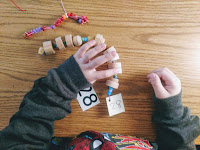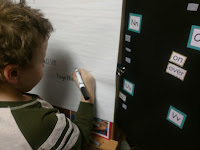All of the children embraced this challenge and successfully found their matches! For some, the challenge was counting how many in the picture, as they are working on developing their 1-to-1 correspondence. For others, the challenge was using their reading strategies to read the number name. Our find your match greetings are differentiated to meet the unique needs of the children. We continue to integrate rich counting and reading opportunities into our morning meetings!


How many beads?
Beading has been a favorite choice during our academic choice. When you bead in the Kindergarten classroom you take on the important job of counting how many beads you used and recording the amount on a small piece of paper. We then hang the beads in our math space, creating a chandelier- a colorful celebration of counting!
While the children are practicing important skills during this experience, the most powerful part is how they are taking initiative of their learning. When recording an amount, instead of asking how to write a number, they go to the 100's chart and find the number they are trying to record. They bring the number card back to the table, record the number, and then return the card to our 100's chart. This is one example of an interactive classroom environment; an environment that supports and encourages students to be independent.








































